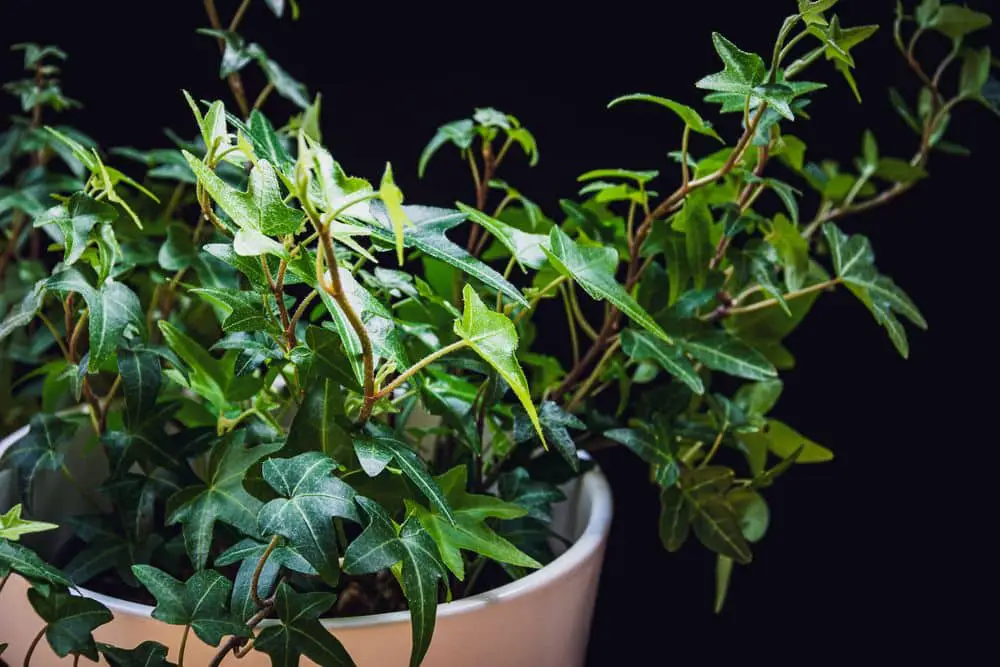Ivy Plants are one of the most common houseplants and a classic favourite. It’s been loved for generations because it is easy to grow as an indoor plant. It can tolerate low light and inconsistent watering and continually grow to its fullest.
Types of Indoor Ivy Plants
There are too many ivy plants to mention here, but five of our favourites are:
English Ivy (Hedera Helix); Devil’s Ivy (Epipremnum Aureum); Algerian Ivy (Hedera Canariensis; Swedish Ivy (Plectranthus Verticillatus); and Grape Ivy (Cissus Rhombifolia).
Our Favourite Varieties of Ivy Plants
1. English Ivy (Hedera Helix)
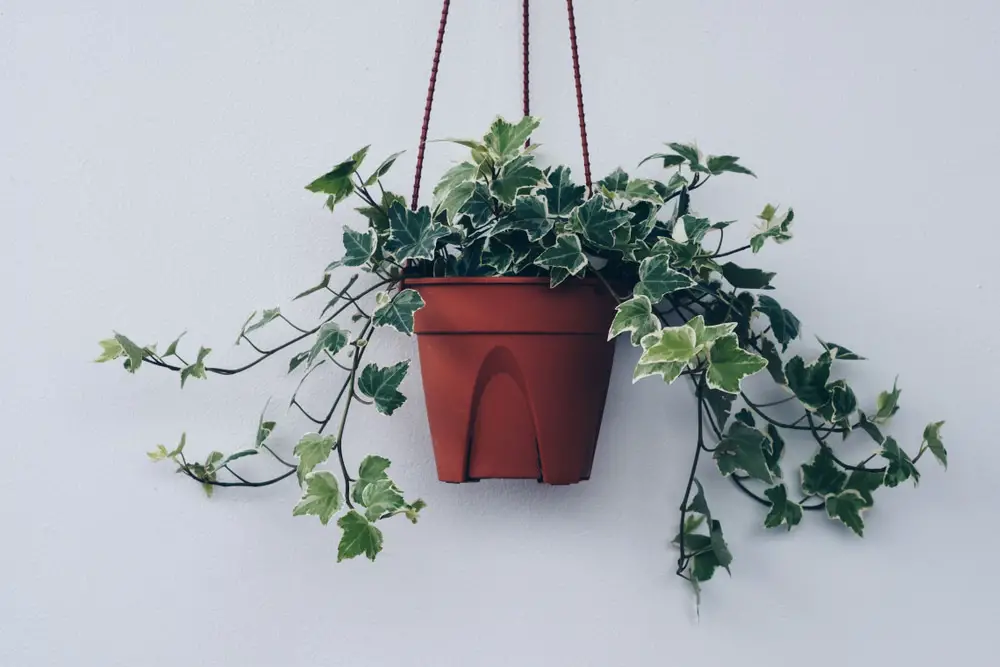
English Ivy is an evergreen perennial and is also classified as a woody vine. It can act as a ground cover. This excellent Ivy would never get out of hand.
An English Ivy can be one of the most beautiful indoor plants with proper care and the right light and water. Excelling in containers, cascading from hanging baskets, and an aggressive climber.
Description and Characteristics
- It is a vine, a creeper that can trail along the ground or grow vertically. Up to the trees, fences, walls, and hillsides.
- The most common type of growth lacks flowers. The leaves have dull green lobes with light veins that grow alternately along trailing.
- Its leaf shape and size vary between varieties. Most of it, from deeply to shallowly lobed. The narrow leaves to large and broadly shaped leaves.
- The mature form of English Ivy has shiny, unlobed leaves that grow in dense and whorl-like clusters.
- This house plant produces umbrella-like groups of small yellow-green flowers during the fall. While in the late winter or early spring, dark purple-black berries appear.
- Its climbing vines form tiny rootlets with a glue-like substance to attach to any surface.
- Typically, the vines grow 90 feet long with stems up to one foot in diameter and can grow up to 300 feet of trees.
English Ivy likes good air circulation. It should not be crowded. It goes well at cool to moderate room temperatures of 50 to 70 °F during the day. A good and rich houseplant potting mix would be fine for English Ivy. It must be planted in a container with good drainage.
Benefits of Growing English Ivy
The English Ivy plant is a ‘beauty with benefits’! Let’s find out, and you will be surprised.
- Excellent Medicinal Uses. It helps for better lung function and proper breathing. It cures respiratory ailments.
- Humidifies Indoor Air. It significantly enhances the humidity of your room as it transpires greatly. Helps maintain the air circulation of your room.
- Purifies the Air. It improves the air quality of your home by preventing air pollutants. It is considered one of the best indoor plants for taking care of the respiratory system.
- Regulate the Temperature of Your Indoors. Maintaining the temperature of your indoors while regulating the warmth and coolness.
- Does not Require High Maintenance. It is a low-maintenance plant. Effortless in keeping it healthy and growing.
- Build a Protective Shield for your House. It protects your walls from salt, frost, and pollution. Does help your homes to get rid of molds.
- Provides Food and Shelter for Birds and Insects. A plant that blooms abundantly throughout and attracts a wide range of birds and animals.
Tips for Care and Maintenance
- English Ivy likes the right light: medium and bright. Moderate light is the best, but it will also do well in bright light. However, you can grow an English Ivy in low light indoors, but it does not like it and would not last as long.
- English Ivy does not like to be overwatered. It doesn’t like wet soil. Keep the soil of this houseplant a little moist.
- English Ivy likes It doesn’t like overly moist soil, but it does like moist air. Increasing the humidity in your home or around your plants.
2. Devil’s Ivy (Epipremnum Aureum)
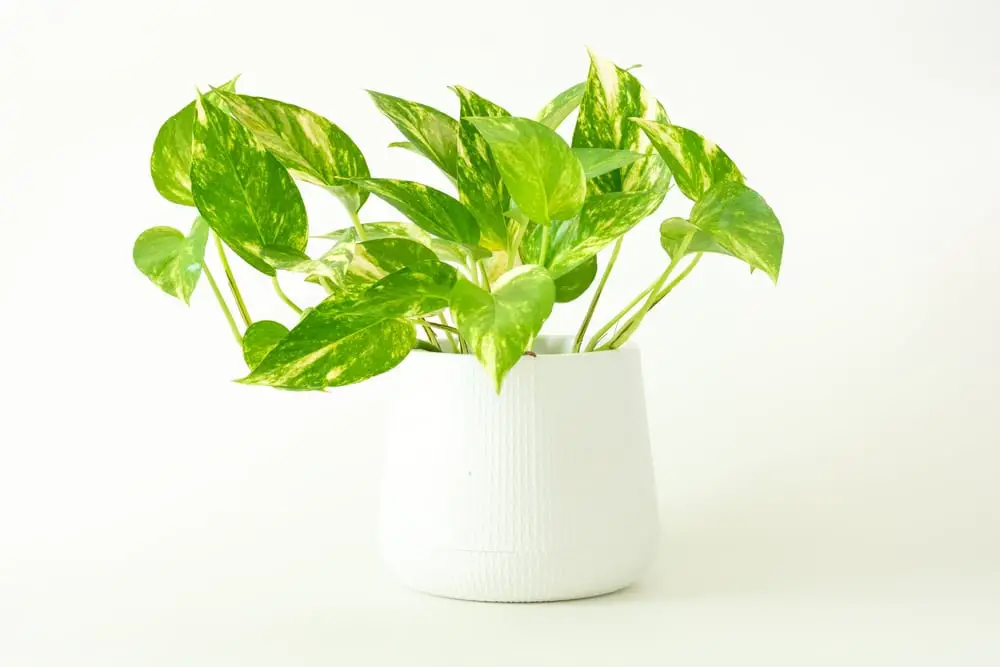
Devil’s Ivy is better known as Pothos or Money Plant. It is a blessing to those who live in a home with little natural light. This kind of plant is almost impossible to kill. Even when kept in the dark, it stays green in colour.
Description and Characteristics
- It is an evergreen house plant with thick, waxy, green, and heart-shaped leaves. With yellow splashes as well.
- It is commonly grown as a hanging plant. It is a creeper and can climb through aerial roots and wild or cultivated plants.
- It has been grown outdoors and can reach enormous heights using tall trees as support.
- The leaves of a Devil’s Ivy outdoors grow many times larger than indoor plants.
- It grows well in a hydroponic setting.
- It is relatively quick to grow. The more prominent examples of the plant are readily available for immediate impact in any room of the home.
Devil’s Ivy likes and will be happy in any room with a temperature between 10-24°C. It does well and is best in bright, indirect light, out of direct sun. But it will also be acceptable in light or even deeper shade. Keep in mind that deep shade may lose its variegation.
Advantages of Having Devil’s Ivy as an Indoor Plant
- It can help reduce air contaminants and airborne mould which may cause asthma, allergies, and other respiratory problems.
- It can significantly help improve the air quality of your home and health issues.
- It is considered a lucky plant in Asian countries. Some believe that it brings money and fortune to homes and offices.
- It has been proven to help remove indoor pollutants. Formaldehyde, trichloroethene, toluene, xylene, and benzene can be found in common home cleaning products.
- Devil’s Ivy is a great houseplant for busy urban dwellers who do not have the benefit of much natural light.
- It makes a lovely addition to any space. The best choice for your home that requires little attention.
Tips for Care and Maintenance
- Water your Devil’s Ivy every 1-2 weeks.
- Allowing soil to dry out between waterings.
- More often, the water is brighter and less in lower light.
- Some signs of overwatering include yellowing of leaves and black stems. While the under-watering will wilt, and their potting mix will dry out.
- Devil’s Ivy prefers average to warm environments (18°C to 25°C) and average humidity.
- Regularly trim the stems to shape the plant to keep your Devil’s Ivy to its fullest and bushiest.
3. Algerian Ivy (Hedera Canariensis)
Algerian Ivy is a sturdy and shade-loving plant. It makes a reliable and attractive ground cover. It is low-maintenance and can quickly adapt to various climates and soil conditions. It is salt tolerant and can be used in coastal landscapes.
Distinguishing Features
- Algerian Ivy is a fast-growing plant. It makes a terrific ground cover for frost-free climates.
- It is a climbing evergreen woody vine with large leaves.
- This Ivy would grow as high as 8-10″ tall.
- Algerian Ivy is thick, shiny, deep green, lobed leaves with reddish stems. While the new growth is a light green colour.
- It is a vigorous, self-clinging climber with lustrous leaves up to 4 or 5 inches across.
Finding out the beauty of an Algerian Ivy in the workplace brightens up the space. It does well at cool to moderate room temperatures of 50 to 70 °F during the day. At night, about 5 to 10 °F.
A good and rich commercial houseplant potting mix will be fine for it. It should be planted in a container with good drainage.
The plant should be given medium light. Not too much, not too little. If you grow it in little light, the plant is likely to die faster. It benefits from good air circulation and should not be crowded.
Benefits and Uses
- Algerian Ivy is one such plant that will quickly establish itself, whereas turf or other plants won’t.
- Placing an Algerian Ivy in the workplace brightens up the space.
- The Algerian Ivy covers buildings and stretches across the ground. It enshrouds anything and everything in its path by covering it with its beauty.
- The beauty of its leaves almost resembles hearts bringing vitality.
- This Ivy will help your workers and clients to breathe cleaner air.
- A fantastic plant rich in plant compounds called saponins and flavonoids. A compound that acts as a potent anti-inflammatory and antioxidant compound that reduces cough.
Tips for Care and Maintenance
- Algerian Ivy likes medium light. Not too much, not too little. Let it grow indoors with a bit of light, the plant is most likely to die.
- This house plant likes fertile and moist soil.
- You need to balance the watering as well. Overwatering can cause brown leaves and dried edges. Underwatering would make it susceptible to insect infestations or disease.
- You can fertilise the Algerian Ivy once every two weeks during the spring and summer.
4. Swedish Ivy (Plectranthus Verticillatus)
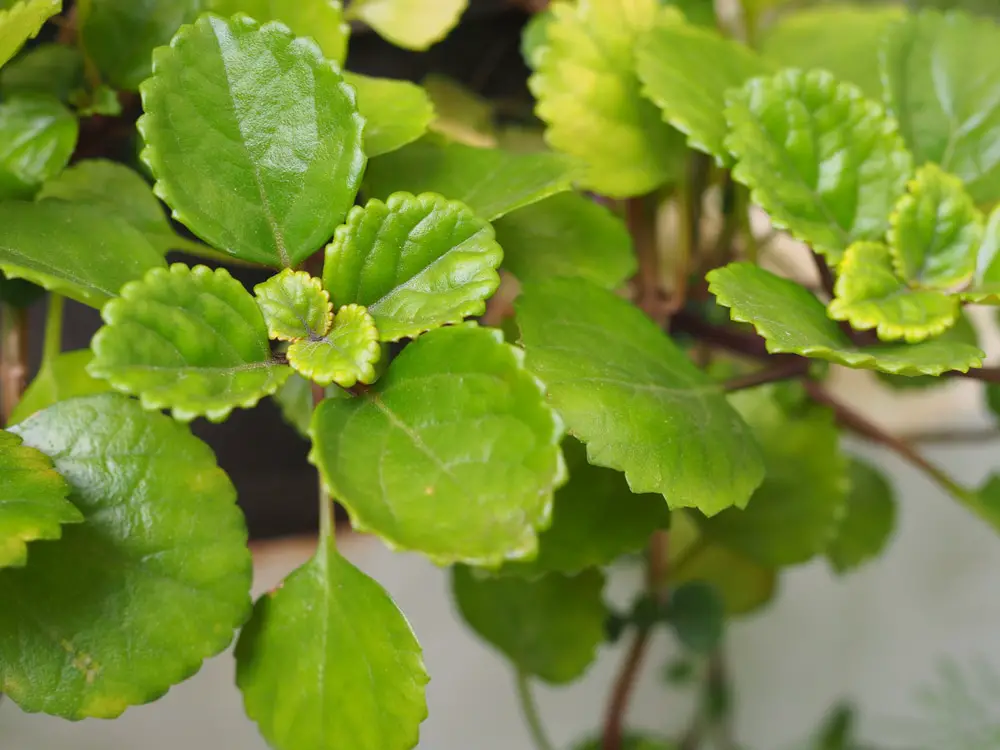
Swedish Ivy is a simple and great houseplant. It grows well indoors and does not require much effort from you to thrive. It was first known as a houseplant in Sweden. This Swedish Ivy has thick stems that could grow erect before cascading. It makes this plant an ideal option for hanging baskets. It is also known as Creeping Charlie.
Description and Features
- Swedish Ivy is a fast-growing and evergreen perennial plant
- It typically could grow to 2-3′ tall on erect stems that trail and spread as they mature.
- Its stem is clad with broad-ovate and glossy green leaves 1.5″ long with crenate margins.
- Swedish Ivy’s foliage is quite beautiful.
- This Ivy has rounded leaves and scalloped edges growing from its stems.
- Many varieties of the plant have variegated leaves. In the late spring or early summer, it is the time to bloom and produce white or pale lavender flowers.
Swedish Ivy likes moderate and indirect light throughout the year, as recommended. However, if its leaves have begun to droop, it could be getting too much light.
The soil should always be slightly moist to avoid overwatering in winter. The average room temperature of Swedish Ivy is about 60 to 75 F. Try to avoid freezing temperatures, as frost will kill it.
Unique Characteristics
- Swedish Ivy has glossy green leaves with scalloped edges.
- The variegated Swedish Ivy has white markings along the edges of the leaves. It makes an attractive accent to the green.
- It produces white or light purple blooms off and on throughout the year.
- Swedish ivy is also known as candlestick vine. It is because it is so easy to grow in the sun and partial shade with an intense citrusy scent.
- Herbaceous annual plant with a trailing habit of growth. It will spill over the edges of hanging baskets. Looking great when it is grown in hanging containers.
- Swedish Ivy’s fine texture is beautiful, unlike other garden plants with less refined foliage.
- It is more appealing to see a ground cover of Swedish Ivy in gardens.
Essential Care
- Swedish Ivy grows well both outdoors and indoors. It requires moderate temperature to grow.
- Observe the top layer to be dry, then water it. This houseplant is very easy to grow and does well if the water level is kept at optimum.
- Avoid keeping the soil soggy. The leaves, which form the key attraction of this plant variety, may lose their shine if kept dry for long intervals.
- Swedish Ivy needs medium light for best results.
5. Grape Ivy (Cissus Rhombifolia)
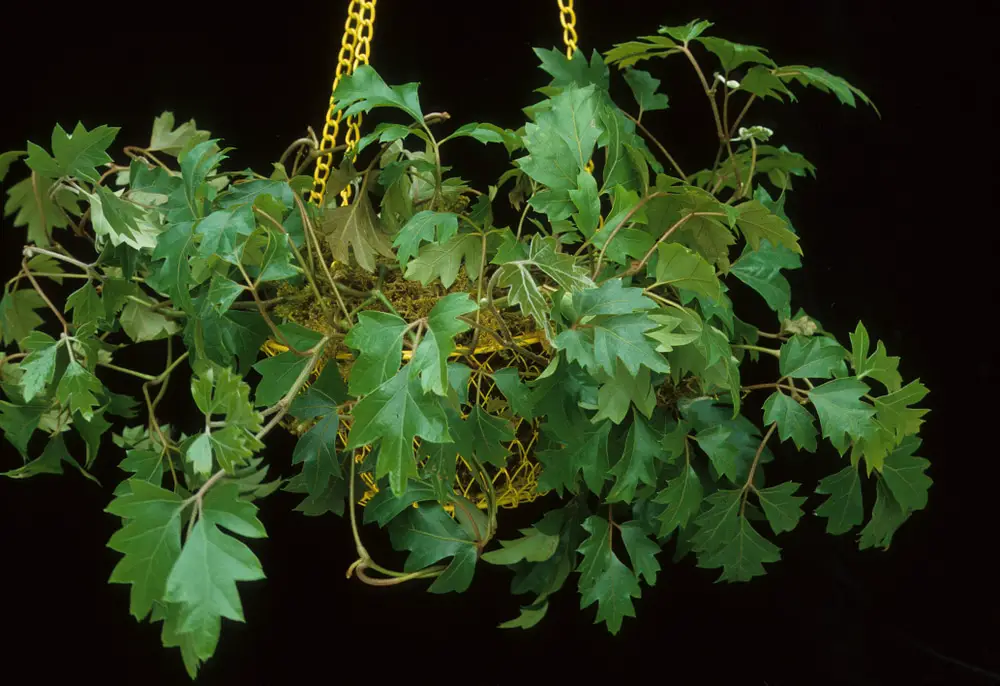
Grape Ivy is a robust, evergreen vine with beautiful, glossy compound leaves. Each bearing 3 leaflets and young leaves is fuzzy, giving them a silvery sheen. This Ivy is adaptable to indoor conditions and makes an easy house plant.
You may place this vine in a hanging basket to show off its beauty with trailing foliage. The sturdy vines would scramble up to support it; it climbs and clings with its curling tendrils.
Indoor Cultivation Requirements
- Grape Ivy is a cultivated vine grown for grapes, wine, and preserves.
- Grape Ivy loves moderate and consistent temperatures. It may range from 68 to 82 degrees Fahrenheit. If anything falls above or below the range, it can inhibit the growth and overall success of the plant.
- This Ivy loves bright light. You can move it outside during summer. it will thrive when the temperature is above 50°F.
Beauty and Decorative Aspects
- Grape Ivy is an attractive indoor ivy with foliage that resembles grape leaves.
- It is a classic houseplant that looks so beautiful cascading from a basket.
- Place it in a container with a trellis.
Important Care Considerations
- Soil considerations are important when growing Grape Ivy as an indoor plant as the root systems require excellent aeration.
- Water your Grape Ivy when its soil dries and dries to the touch. Then water the plant thoroughly and allow excess water to drain out of the bottom of the pot.
- Pinching regularly will keep your grape Ivy compact and bushy.
Generally Speaking
An evergreen vine, Ivy looks excellent in a hanging basket or letting it trail over the sides of a pot. Just allow it to climb to become a living curtain.
A wide range of varieties of Ivies are available. Most have colourful variegated foliage with different leaf shapes.
Look around to make sure you find the best ivy for you! You can start a collection of this easy-to-grow houseplant.
With all its versatility, it’s no wonder Ivies are among the most popular varieties in the collection of Exotic Angel Plants!
Grow your Ivy in medium light for the best results. It does well with bright light indoors and even a small amount of direct sun for its foliage. The Ivy varieties have white variegation on their leaves. They are more susceptible to damage from too much sun.
Somehow, you miss watering, and your ivy wilts, don’t worry! It can recover after you give it a splash of water. But take care not to overwater. It’s best to keep Ivy a little too dry rather than wet.
Final Thoughts on Types of Indoor Ivy Plants
While we often think of plants thriving indoors, we all know Ivy is a popular houseplant, and with proper care, it can grow well indoors.
Ivy plants have a lot to offer and some surprising benefits. It’s a shade-tolerant, easy-to-grow, and evergreen vine.
It is a creeper that can trail, climb along your walls, and grow vertically. Looks so beautiful cascading from hanging baskets in your home. A houseplant may help to purify the air and provide antioxidant and anti-inflammatory benefits.
It appears to be helpful in reducing coughs related to colds and viral infections.
Why would you love it? Ivies make great indoor plants and thrive with ease. If you haven’t had one before, you will find it so easy to grow and maintain, and so attractive and compliment creating, that it may end up being your plant to have for life!
Do you ever wonder why elitist academic groups are known as Ivy Leagues?

